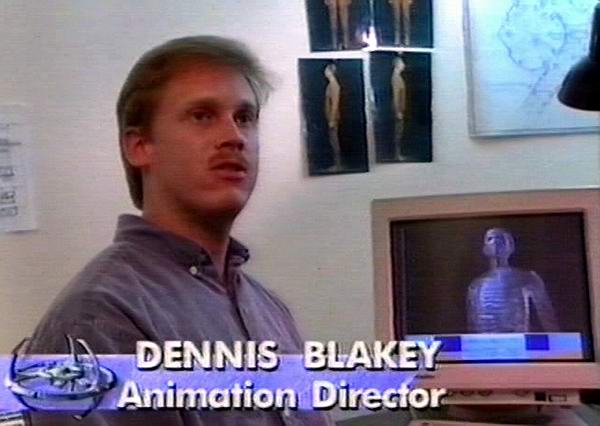
Title
Date
Description
Multiple Available
There are multiple entries on this date. You can modify the date range below to see them all.
Wavefront
Established Date: June 4, 1984
- All
- animation
- CalArts
- Dale McBeath
- Silicon Graphics
- Cubicomp
- Maya
- Alias
- Vibeke Sorensen
- Dennis Blakey
- IRIS 3020
- obj
- SGI
- Wavefront
- Houdini
- Side Effects Software
- JPL
- California Institute of the Arts
- Prisms
- Digital Domain
- Mojo
- Star Trek
- Deep Space Nine
- Apollo 13
- Project Galileo
- Ultimatte
- Tron Legacy
- Storm
- CAPS
- Home on the Range
- Disney
- software
- compositing
- pioneer
- co-founder
- France
- TDI
- visual effects
- film
- production
- founder
- software engineer
- artist
- scanimate
- technical director
- animator
- designer
- video games
-
Larry Barels, Bill Kovacs, and Mark Sylvester founded Wavefront Technologies in 1984. The company created its first product, an animation software application called PreView, and shipped it to Universal Studios for use on the television series Knight Rider and to Lamb & Company for use in previsualizing and controlling a motion control camera rig. During the next several years, the product line expanded to include modeling, rendering, compositing, and material-editing capabilities.
-
The company's first real competition came in 1987 with the advent of Robert Abel & Associates' software division, Abel Image Research (AIR). This company, originally founded on a code base developed by Bill Kovacs, was started to capitalize on the momentum Wavefront was enjoying in the marketplace. This software was incomplete, undocumented, and very expensive, but AIR had the best marketing materials in the industry with an award-winning animation reel done by Robert Abel. Unable to compete against this body …
Able Image Research software -
The company originally was financed by the founders for the first year. Then it went through several rounds of venture funding, culminating in an IPO 10 years later in 1995. Initial revenues were in the several hundred thousand per year range and ended in 1994 with annual revenues around $26 million.
early funding and revenue -
The company went from three founders and four employees to 12, then 28, then 50, then 90, and then 160 at its highest point in the late '80s. Expansion into Europe happened in 1987 with the creation of Wavefront Europe, located in Belgium. At that time, the Belgian government also became an investor. The next year, concurrent with the AIR acquisition, Wavefront moved into Japan and then throughout the rest of Asia. In the early '90s, a round of funding …
more funding partners and expansion -
In 1993, Wavefront entered into discussions to acquire another of the pioneering computer graphics companies, Thomson Digital Images (TDI). TDI had developed a similar set of technologies in modeling, animation, and rendering and had innovated in the area of NURBS modeling and interactive rendering. These technologies coupled with extensive distribution in Europe and Asia made for an ideal fit with Wavefront. The acquisition was treated more as a merger, but more than half the employees of TDI left immediately. It …
acquisition of TDI -
In 1993, the company entered the electronic game market with a repackaging of its core application, The Advanced Visualizer, into a tailored offering called GameWare. This bundle focused the marketplace on Wavefront for game development and was very successful. This effort lasted for one year until the merger of Alias and Wavefront, when the program was canceled so PowerAnimator could be sold to game developers instead.
GameWare -
The original business plan talked about military, educational, medical, electronic game, simulation, film/entertainment, engineering, and product visualization marketplaces. The only one that never materialized was the simulation market. The company expanded into the scientific market in the late '80s with a product called The Data Visualizer. This product, aimed at nonpolygonal databases, was a success until Silicon Graphics and IBM developed competing products that were offered for free in bundles to sell high-end server hardware into the scientific marketplace. The …
Data Visualizer -
The company made one foray into the desktop marketplace with a project co-developed by Silicon Graphics called The Personal Visualizer. This product was created to give CAD users a point-and-click interface to high-end photorealistic rendering. Initially targeted to SGI hardware, the product eventually was ported to Sun, IBM, HP, Tektronix, DEC, and Sony platforms. The strategy was to bundle the software on every system sold and then follow with module sales into the installed base.
Personal Visualizer -
In the film market, Disney was the premier customer along with Warner Digital and Boss Film (both now defunct), Industrial Light & Magic, Film Magic (Hong Kong), TRIX (Belgium), and Electronic Arts (London). In video production, NBC, CBS, ABC, and CNN (Turner Broadcasting) were the premier partners. In engineering visualization, there was Harvard, National Center for Atmospheric Research (NCAR), NASA (six locations), Alcoa, and the National Center for Supercomputing Applications (NCSA). The military visualization marketplace included the CIA, FBI, Naval …
major customers -
In early 1995, another effort was undertaken to capture the architectural market. ArcVision was designed to take existing CAD translation software and bundle it with preset color and environment controls, using IPR (Explore's renderer front-end) to offer a low-cost solution to small firms that wanted to experiment with different color and lighting schemes using existing CAD architectural databases. This project was terminated postmerger because the Alias management had bad experiences in this market with their Sonata purchase and did not …
ArcVision -
In 1998, a Scientific and Technical Achievement Award was awarded to Jim Keating, Michael Wahrman, and Richard Hollander for their contributions that led to the Wavefront Advanced Visualizer computer graphics system. Also in 1998, a Scientific and Engineering Award was presented to Bill Kovacs for his creative leadership and to Roy Hall for his principal engineering efforts that led to the Wavefront Advanced Visualizer computer graphics program.
Academy Awards -
In June of 1995, the merger of Alias Research, Wavefront, and Silicon Graphics was completed.
triple merger -
The company enjoyed early relationships with key partners that shaped the direction of the products and the marketplace. Those early partners included Disney (The Great Mouse Detective), NASA (the Shuttle accident re-creation), NBC (the 1986 Olympics), and Failure Analysis (legal animations, including the World Airways crash at Logan Airport in Boston).
Early partners and clients -
 Classic Logo - 1984
Classic Logo - 1984 -
 .obj file format
.obj file format -
 California Institute of the Arts Computer Lab
California Institute of the Arts Computer Lab -
 Dennis Blakey
Dennis Blakey -
 Wavefront Composer
Wavefront Composer -
 Kleiser Walczak Construction Company
Kleiser Walczak Construction Company -
 Jeff Kleiser
Jeff Kleiser -
 Michael Wahrman
Michael Wahrman -
 Thomson Digital Image ( TDI )
Thomson Digital Image ( TDI ) -
 Diana Walczak
Diana Walczak -
 Richard Hollander
Richard Hollander -
 Santa Barbara Studios
Santa Barbara Studios -
 John Grower
John Grower -
 Richard ( Doc ) Baily
Richard ( Doc ) Baily -
 Mark Sylvester
Mark Sylvester -
 Bill Kovacs
Bill Kovacs -
 Ed Kramer
Ed Kramer -
 Jeffery A. Williams
Jeffery A. Williams
Able Image Research software
The company's first real competition came in 1987 with the advent of Robert Abel & Associates' software division, Abel Image Research (AIR). This company, originally founded on a code base developed by Bill Kovacs, was started to capitalize on the momentum Wavefront was enjoying in the marketplace. This software was incomplete, undocumented, and very expensive, but AIR had the best marketing materials in the industry with an award-winning animation reel done by Robert Abel. Unable to compete against this body of work, a deal was struck in 1988 that had Wavefront purchasing the assets of AIR. The AIR software was never incorporated into the Wavefront code bases, even though urban myths have contrary opinions.
early funding and revenue
The company originally was financed by the founders for the first year. Then it went through several rounds of venture funding, culminating in an IPO 10 years later in 1995. Initial revenues were in the several hundred thousand per year range and ended in 1994 with annual revenues around $26 million.
more funding partners and expansion
The company went from three founders and four employees to 12, then 28, then 50, then 90, and then 160 at its highest point in the late '80s. Expansion into Europe happened in 1987 with the creation of Wavefront Europe, located in Belgium. At that time, the Belgian government also became an investor. The next year, concurrent with the AIR acquisition, Wavefront moved into Japan and then throughout the rest of Asia. In the early '90s, a round of funding with CSK, a major Japanese computer company, resulted in the founding of Wavefront Japan, a wholly owned subsidiary. CSK at one time owned 14 percent of Wavefront.
acquisition of TDI
In 1993, Wavefront entered into discussions to acquire another of the pioneering computer graphics companies, Thomson Digital Images (TDI). TDI had developed a similar set of technologies in modeling, animation, and rendering and had innovated in the area of NURBS modeling and interactive rendering. These technologies coupled with extensive distribution in Europe and Asia made for an ideal fit with Wavefront. The acquisition was treated more as a merger, but more than half the employees of TDI left immediately. It took nearly two years to blend the distribution channels in Europe and Asia because Wavefront had a toehold in those areas already. Fierce competition between the channels was clearly in play.
GameWare
In 1993, the company entered the electronic game market with a repackaging of its core application, The Advanced Visualizer, into a tailored offering called GameWare. This bundle focused the marketplace on Wavefront for game development and was very successful. This effort lasted for one year until the merger of Alias and Wavefront, when the program was canceled so PowerAnimator could be sold to game developers instead.
Data Visualizer
The original business plan talked about military, educational, medical, electronic game, simulation, film/entertainment, engineering, and product visualization marketplaces. The only one that never materialized was the simulation market. The company expanded into the scientific market in the late '80s with a product called The Data Visualizer. This product, aimed at nonpolygonal databases, was a success until Silicon Graphics and IBM developed competing products that were offered for free in bundles to sell high-end server hardware into the scientific marketplace. The Data Visualizer built on Wavefront's reputation for open systems and fast graphics interaction.
Personal Visualizer
The company made one foray into the desktop marketplace with a project co-developed by Silicon Graphics called The Personal Visualizer. This product was created to give CAD users a point-and-click interface to high-end photorealistic rendering. Initially targeted to SGI hardware, the product eventually was ported to Sun, IBM, HP, Tektronix, DEC, and Sony platforms. The strategy was to bundle the software on every system sold and then follow with module sales into the installed base.
major customers
In the film market, Disney was the premier customer along with Warner Digital and Boss Film (both now defunct), Industrial Light & Magic, Film Magic (Hong Kong), TRIX (Belgium), and Electronic Arts (London). In video production, NBC, CBS, ABC, and CNN (Turner Broadcasting) were the premier partners. In engineering visualization, there was Harvard, National Center for Atmospheric Research (NCAR), NASA (six locations), Alcoa, and the National Center for Supercomputing Applications (NCSA). The military visualization marketplace included the CIA, FBI, Naval Surface Warfare Center, U.S. Air Force, and the National Security Agency. At the high point, there were nearly 8,000 Advanced Visualizer users.
ArcVision
In early 1995, another effort was undertaken to capture the architectural market. ArcVision was designed to take existing CAD translation software and bundle it with preset color and environment controls, using IPR (Explore's renderer front-end) to offer a low-cost solution to small firms that wanted to experiment with different color and lighting schemes using existing CAD architectural databases. This project was terminated postmerger because the Alias management had bad experiences in this market with their Sonata purchase and did not believe the market was viable. It never really got off the ground because it was scheduled to be launched at Siggraph 1995.
Academy Awards
In 1998, a Scientific and Technical Achievement Award was awarded to Jim Keating, Michael Wahrman, and Richard Hollander for their contributions that led to the Wavefront Advanced Visualizer computer graphics system. Also in 1998, a Scientific and Engineering Award was presented to Bill Kovacs for his creative leadership and to Roy Hall for his principal engineering efforts that led to the Wavefront Advanced Visualizer computer graphics program.
triple merger
In June of 1995, the merger of Alias Research, Wavefront, and Silicon Graphics was completed.
Early partners and clients
The company enjoyed early relationships with key partners that shaped the direction of the products and the marketplace. Those early partners included Disney (The Great Mouse Detective), NASA (the Shuttle accident re-creation), NBC (the 1986 Olympics), and Failure Analysis (legal animations, including the World Airways crash at Logan Airport in Boston).
Larry Barels, Bill Kovacs, and Mark Sylvester founded Wavefront Technologies in 1984. The company created its first product, an animation software application called PreView, and shipped it to Universal Studios for use on the television series Knight Rider and to Lamb & Company for use in previsualizing and controlling a motion control camera rig. During the next several years, the product line expanded to include modeling, rendering, compositing, and material-editing capabilities.
